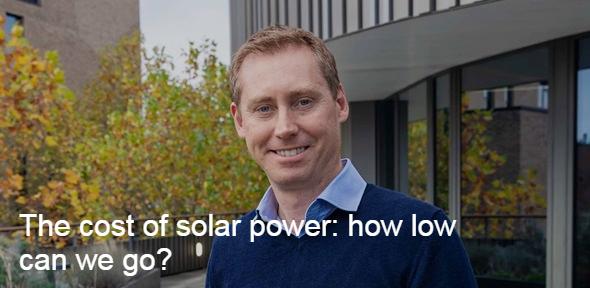
Professor Sam Stranks is developing next-generation solar cell technology, which could drive down renewable energy prices even further.
Although it may feel as if the news around climate change is unrelentingly negative, there are some remarkably bright spots. One of the brightest is solar energy.
In just the last ten years, the cost of solar cells has fallen by 90%. Over four decades, solar has transformed from one of the most expensive electricity sources to the cheapest in many countries. But we still have further to go.
To implement and expand solar energy worldwide, we need to make it cheaper and more efficient than silicon, the dominant material used for solar cells today. One way to do this is to make solar cells from materials that can use more of the solar spectrum than silicon can, which would make them more efficient.
he most promising replacement for silicon is a family of materials called perovskites. Perovskites are cheaper than silicon and make excellent solar cells: their overall energy output can often meet or – in the case of multi-layered ‘tandem’ devices – exceed that of traditional silicon solar cells. However, they are not yet stable enough to operate at high performance for many years.
“Because perovskite devices are much cheaper to produce, they may not need to have as long a lifetime as their silicon counterparts to enter some markets. But to fulfil their ultimate potential, perovskite solar cells will need to reliably operate for at least a decade or more,” Professor Sam Stranks, Department of Chemical Engineering and Biotechnology
In his lab at Cambridge’s Department of Chemical Engineering and Biotechnology, Professor Sam Stranks is studying how perovskites degrade over time, to improve their efficiency and stability.
Stranks’ team uses specialised microscopy techniques to study defects in the perovskites, enabling them to get highly detailed pictures at the micro- or even the nanoscale. They also simulate how perovskite devices work under sunlight, testing them continuously for thousands of hours under artificial sunlight, or under high-stress conditions by increasing temperature or humidity levels. These tests help them understand how and when the devices break.
These results are then taken back to their fabrication lab, where changes can be made to the composition of the materials, or how they are layered, to improve performance.
Stranks is a co-founder of Swift Solar, a company dedicated to developing high-performance perovskite solar modules scaled for global energy needs. The company builds on the advances made in Stranks’ Cambridge lab, which have resulted in tangible enhancements in perovskite efficiency, lifespan and stability.

